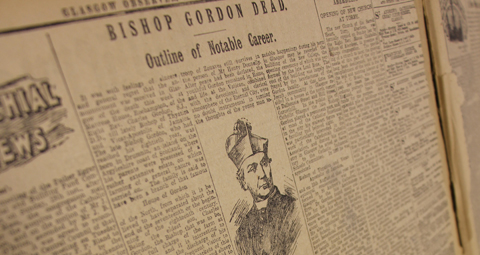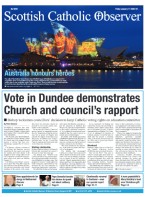November 3 | ![]() 0 COMMENTS
0 COMMENTS ![]() print
print

The Scots who fought for the Pope
The papal army, the Italian nationalist and the Scottish Catholics who joined the forces of Pius IX: 150 years after the last victory for papal troops, GERALD WARNER reveals the story of the Scotsmen who took on Garibaldi’s army to defend the rights of the Vicar of Christ -By GERALD WARNER
EXACTLY 150 years ago, on November 3, 1867, the papal army of Pius IX won a crushing victory over Giuseppe Garibaldi and his Redshirts at the Battle of Mentana. It was the last victory won by an army in the service of the Vicar of Christ.
The papal general Kanzler commanded a force of 5,000 men; 3,000 papal soldiers and 2,000 French regular troops who brought up the rear. Garibaldi led around 10,000 Redshirts advancing on Rome. The papal army confronted them at the village of Mentana. From noon on November 3, the feast of St Hubert, the Zouave regiment of international volunteers charged one Redshirt position after another at bayonet point and threw back the invaders.
By mid-afternoon, Garibaldi had fled the field, accompanied by many of his men. Only in the later stages of the battle did the French regulars engage the Redshirts. Since some of them were armed with the formidable new chassepot rifle, the face-saving myth was concocted by the Garibaldians that they had been defeated by superior military technology. In fact they had been defeated at bayonet point by the Pope’s Catholic volunteers.
The war in defence of the Papal States, sometimes called the Ninth Crusade, was fought against Garibaldi’s Italian nationalists and the Kingdom of Piedmont that forcibly incorporated the other Italian states into a new Kingdom of Italy. By 1867, all that remained to Pope Pius IX was the Patrimony of St Peter, centred on Rome. It had been granted in 754 by the Donation of King Pepin III of the Franks to Pope Stephen II, to ensure the Pope’s independence from secular rulers.
Volunteers of all nationalities— French, Belgians, Dutch and many others—flocked to the papal colours: the army of Pope Pius IX included an Indian and a South Sea Islander. These foreign volunteers were mainly enrolled in the exotic regiment of Papal Zouaves, a romantic and dedicated force.
So thought one Scottish Catholic, observing the plight of Pope Pius IX from remote Argyllshire. Charles Menzies Gordon was a younger son of Sir Charles Gordon of Drimnin, a successful Edinburgh lawyer. The Gordons, however, were not native to Argyllshire: their roots lay in the Gordon lands in Aberdeenshire where for generations they had been lairds of Minmore.
The heritage of the Gordons of Minmore was uncompromisingly Catholic and Jacobite. According to family tradition, Charles Menzies Gordon’s great-grandfather John Gordon, fourth Laird of Minmore, had commanded the bodyguard that escorted Prince Charlie from the battlefield of Culloden. The muster roll of the Jacobite army shows John Gordon of Minmore was indeed a captain in the Regiment of Gordon of Glenbucket, a detachment of which guarded the Prince.
It was an ancient house. Charles Menzies Gordon’s ninth great-grandfather was a cousin of the founder of the line of the Dukes of Gordon. Born on March 5, 1831, Charles took over the running of his family’s Argyllshire estate after his father’s death. He carried out improvements on his land and was to be seen, in Highland dress, dealing in the cattle markets in Inverness and Glasgow where he earned the reputation of driving a hard, but fair, bargain
In 1867, however, he turned his thoughts to weightier matters. Catholics from around the world were crowding into Rome to fight for the Pope: why was a warlike nation like Scotland not involved?
He envisioned recruiting an army of kilted Highland warriors to defend the capital of Christendom. He did his actual recruiting in Glasgow.
His plan was to enlist a first batch of 60 volunteers and hasten with them to Rome where a battle was imminently expected, leaving a second contingent of 100 men, apparently partly recruited from America, to follow on.
Gordon arrived in Rome with his 60 volunteers but was too late to fight at Mentana. Nevertheless, everybody knew the Piedmontese and Garibaldi would strike back soon, so the papal army was still enlisting volunteers. Some of the Scots were enrolled in the Zouaves where they were attired in North African-style uniforms in grey piped with red and baggy breeches: kilts were not a practical proposition.
There seems to have been a more serious problem, however. In January, 1868 the London-based Morning Post reported: “The Scotch volunteers for the Highland company in the Papal Zouave Regiment having turned out to be chiefly Irish, and, smacking of Fenianism have been dismissed by the Pope…”
The Morning Post was a Tory paper, obsessed with the horrors of Fenianism, so that report is not necessarily to be credited. There were already 300 Irishmen in the Zouaves and Irish soldiers had served in the papal army from the beginning of the war.
However, Gordon’s recruits were probably largely Irish immigrants from Glasgow with more radical sympathies than their countrymen already in the Zouaves and, although devout Catholics, would have been identified by the Roman authorities as similar in political outlook to the Redshirts.
Nevertheless, some of Gordon’s volunteers did serve in the Zouaves, though these Scots often had Irish antecedents. Milton of Campsie supplied three young men who travelled together to Rome and donned Zouave uniform: John Gallagher, ‘Taig’ McCahill and Patrick Kenny.
John Gallagher, 23, was the son of a coalminer. He survived the three-year-long Roman campaign and returned to Campsie where he rose to be foreman of a print works and was married three times (as a serial widower), dying there at the age of 70 in 1915.
From Glasgow came John Hamilton, whose father Henry was a maker of tobacco pipes. His Zouave son was described as ‘a man of few words, he was also a man of action.’
He lived up to that reputation in the ranks of the Zouaves and also survived the war in the Papal States, returning to Glasgow to become a stalwart of the parish of Parkhead where he died at the relatively young age of 54.
These men from humble backgrounds served in the Zouave ranks alongside the Scottish nobleman the Hon Walter Constable Maxwell, youngest son of the 10th Lord Herries, who had made his way to Rome independently of Charles Gordon.
He survived the war, later becoming a rancher in Kansas, and produced seven daughters all of whom became nuns. The Marquis of Bute, then in Rome, was a great benefactor of the Zouaves. Throughout the papal army there was a mixture of classes as well as nationalities, mirroring the universality of the Church.
All the English-speaking Zouaves were received in private audience by Pope Pius IX on the Feast of Corpus Christi, June 11, 1868, and presented individually to the grateful pontiff—an event they would remember for the remainder of their lives.
Unhappily, their crusade finally ended in defeat on that heartbreaking day, September 20, 1870, when Pope Pius IX ordered his troops to surrender, to save further bloodshed, after the walls of Rome had been breached at the Porta Pia by the vastly superior Piedmontese army. By that time, Charles Menzies Gordon was no longer in uniform. In 1869 he discerned a vocation to the priesthood and in November began his studies to become a Jesuit.
He was ordained in 1878 and at the end of 1881 was appointed rector of St Aloysius’ College, Garnethill, in Glasgow. Fr Gordon was responsible for the building of the new college, where he served as rector until 1889. On May 28, 1889, he was appointed Bishop of Thyatira in partibus and Vicar Apostolic of Jamaica; he was consecrated bishop by Count Eyre, Archbishop of Glasgow, on the Feast of the Assumption, 1889.
The Right Rev Charles Gordon SJ served as Vicar Apostolic in Jamaica until 1906 when he retired. He died at the Jesuit house at Roehampton on November, 16, 1911, after an energetic life spent in the service of God.
That energy had ensured that Scotland made its contribution to defending the rights of the Vicar of Christ.










